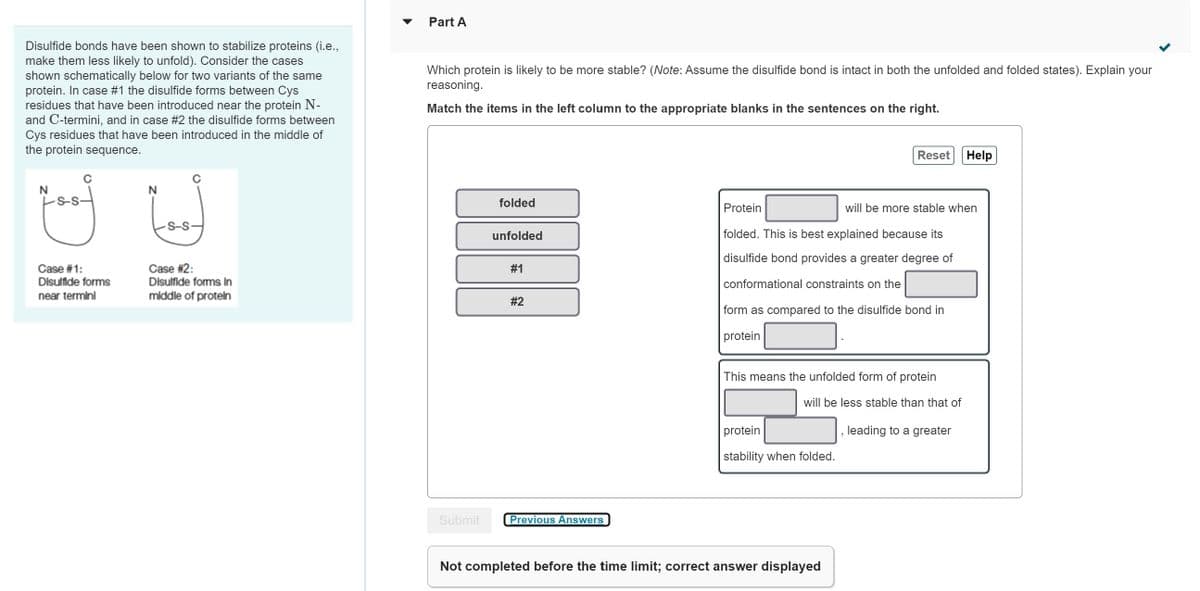Disulfide bonds have been shown to stabilize proteins (i.e., make them less likely to unfold). Consider the cases shown schematically below for two variants of the same protein. In case #1 the disulfide forms between Cys residues that have been introduced near the protein N- and C-termini, and in case # 2 the disulfide forms between Cys residues that have been introduced in the middle of the protein sequence. foof Case #1: Disulfide forms near termini N s-s- Case #2: Disulfide forms in middle of protein ▼ Part A Which protein is likely to be more stable? (Note: Assume the disulfide bond is intact in both the unfolded and folded states). Explain your reasoning. Match the items in the left column to the appropriate blanks in the sentences on the right. folded unfolded #1 # 2 Reset Help Protein will be more stable when folded. This is best explained because its disulfide bond provides a greater degree of conformational constraints on the form as compared to the disulfide bond in protein This means the unfolded form of protein will be less stable than that of leading to a greater protein stability when folded.
Disulfide bonds have been shown to stabilize proteins (i.e., make them less likely to unfold). Consider the cases shown schematically below for two variants of the same protein. In case #1 the disulfide forms between Cys residues that have been introduced near the protein N- and C-termini, and in case # 2 the disulfide forms between Cys residues that have been introduced in the middle of the protein sequence. foof Case #1: Disulfide forms near termini N s-s- Case #2: Disulfide forms in middle of protein ▼ Part A Which protein is likely to be more stable? (Note: Assume the disulfide bond is intact in both the unfolded and folded states). Explain your reasoning. Match the items in the left column to the appropriate blanks in the sentences on the right. folded unfolded #1 # 2 Reset Help Protein will be more stable when folded. This is best explained because its disulfide bond provides a greater degree of conformational constraints on the form as compared to the disulfide bond in protein This means the unfolded form of protein will be less stable than that of leading to a greater protein stability when folded.
Biochemistry
9th Edition
ISBN:9781319114671
Author:Lubert Stryer, Jeremy M. Berg, John L. Tymoczko, Gregory J. Gatto Jr.
Publisher:Lubert Stryer, Jeremy M. Berg, John L. Tymoczko, Gregory J. Gatto Jr.
Chapter1: Biochemistry: An Evolving Science
Section: Chapter Questions
Problem 1P
Related questions
Question
61.12

Transcribed Image Text:Disulfide bonds have been shown to stabilize proteins (i.e.,
make them less likely to unfold). Consider the cases
shown schematically below for two variants of the same
protein. In case #1 the disulfide forms between Cys
residues that have been introduced near the protein N-
and C-termini, and in case #2 the disulfide forms between
Cys residues that have been introduced in the middle of
the protein sequence.
N
goof
Case #1:
Disulfide forms
near terminl
N
S-S-
Case #2:
Disulfide forms in
middle of protein
Part A
Which protein is likely to be more stable? (Note: Assume the disulfide bond is intact in both the unfolded and folded states). Explain your
reasoning.
Match the items in the left column to the appropriate blanks in the sentences on the right.
Submit
folded
unfolded
#1
#2
Previous Answers
Reset
Protein
will be more stable when
folded. This is best explained because its
disulfide bond provides a greater degree of
conformational constraints on the
form as compared to the disulfide bond in
protein
This means the unfolded form of protein
will be less stable than that of
protein
stability when folded.
Not completed before the time limit; correct answer displayed
Help
leading to a greater
Expert Solution
This question has been solved!
Explore an expertly crafted, step-by-step solution for a thorough understanding of key concepts.
This is a popular solution!
Trending now
This is a popular solution!
Step by step
Solved in 3 steps with 1 images

Recommended textbooks for you

Biochemistry
Biochemistry
ISBN:
9781319114671
Author:
Lubert Stryer, Jeremy M. Berg, John L. Tymoczko, Gregory J. Gatto Jr.
Publisher:
W. H. Freeman

Lehninger Principles of Biochemistry
Biochemistry
ISBN:
9781464126116
Author:
David L. Nelson, Michael M. Cox
Publisher:
W. H. Freeman

Fundamentals of Biochemistry: Life at the Molecul…
Biochemistry
ISBN:
9781118918401
Author:
Donald Voet, Judith G. Voet, Charlotte W. Pratt
Publisher:
WILEY

Biochemistry
Biochemistry
ISBN:
9781319114671
Author:
Lubert Stryer, Jeremy M. Berg, John L. Tymoczko, Gregory J. Gatto Jr.
Publisher:
W. H. Freeman

Lehninger Principles of Biochemistry
Biochemistry
ISBN:
9781464126116
Author:
David L. Nelson, Michael M. Cox
Publisher:
W. H. Freeman

Fundamentals of Biochemistry: Life at the Molecul…
Biochemistry
ISBN:
9781118918401
Author:
Donald Voet, Judith G. Voet, Charlotte W. Pratt
Publisher:
WILEY

Biochemistry
Biochemistry
ISBN:
9781305961135
Author:
Mary K. Campbell, Shawn O. Farrell, Owen M. McDougal
Publisher:
Cengage Learning

Biochemistry
Biochemistry
ISBN:
9781305577206
Author:
Reginald H. Garrett, Charles M. Grisham
Publisher:
Cengage Learning

Fundamentals of General, Organic, and Biological …
Biochemistry
ISBN:
9780134015187
Author:
John E. McMurry, David S. Ballantine, Carl A. Hoeger, Virginia E. Peterson
Publisher:
PEARSON